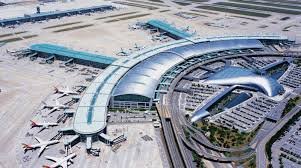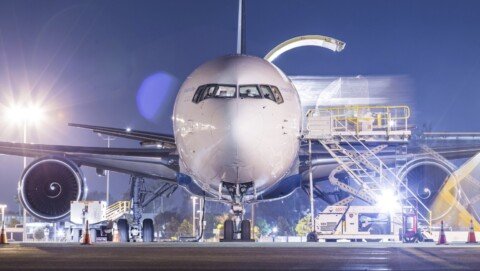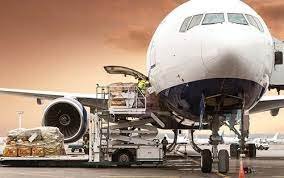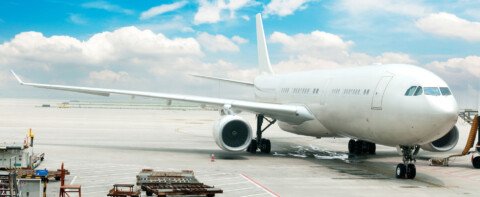Air cargo volumes have been more resilient to coronavirus pandemic-related effects than passenger traffic activity. From the last few months, the business is showing signs of recovery with a rise in exports and addition of freighter services at major airports. Now, as rolling out of COVID vaccines has started in some countries, and is expected to begin soon in the rest of the world, hub airports in the US and Europe have built up all necessary infrastructure and bracing themselves to handle what will possibly be the largest and most critical distribution programme in recent history.
Upamanyu Borah
Foreword
Air cargo is frequently used to transport high-value, time-sensitive commodities and, more recently, personal protective equipment (PPE), ventilators and other medical equipment. Air cargo demand was driven by both, urgency to obtain these supplies and the need to fill in for supply chains that had been disrupted due to stay-at-home orders and travel restrictions.
There are many cases of commercial airports which have found that building a cargo business is a better option than a passenger one. That realisation almost came about by accident as passenger traffic slumped alarmingly amid the pandemic – but freight volume carried on growing.
In the past, airports have been consistently late in anticipating and meeting air cargo facility demand. This delay created a very predictable infrastructure crisis. In case after case, a shortage of efficient, properly located, air cargo facilities is preceded by a carrier or carriers expressing a serious unmet need for greater and more efficient space. Efficiency is the key – a cargo facility should be the right size and configuration for the potential market.
Looking at current situation, although many feel its airports rather than airlines that could be most at risk of unpreparedness, one thing is to be emphasised, no one would dare to indulge in this kind of misadventure if they are not fully prepared or lack the necessary infrastructure and systems. After all, its airports that have managed to accommodate the rising movement of shipments whether e-commerce, pharmaceuticals, and consumer goods or perishables, as demand grows with an ever-growing global population, emerging markets and the new geography of trade.
Governments across the world are already considering ways in which it will work with their aviation sectors for smooth transportation of the vaccine, which will require state-of-the-art time and temperature-sensitive storage and transportation infrastructure.
Airports have planned and created dedicated task forces in conjunction with their airline partners to facilitate vaccine transportation. The teams will undertake advance planning and collaborate with all stakeholders such as regional airports, airline customers, supply chain partners, regulatory and governmental bodies, and vaccine distributors. Such advance planning could go a long way in making the transportation process seamless.
The task forces will extend all efforts to optimise temperature management, reduce dwell time with prior special approvals from regulators, and lower processing time in order to ensure an unbroken cold chain for the vaccine movement from the manufacturing facility to the end distributor.
Besides personnel capabilities, airports are also planning to dedicate their infrastructure capabilities towards vaccine storage and distribution.
Cargo and Cold Chain Infrastructure
Hartsfield-Jackson Atlanta International Airport (ATL)
A city within a city, the success of the giant Hartsfield-Jackson Atlanta International Airport (ATL) keeps tens of thousands employed across Georgia.
There are industries prevalent in Southeast USA, and many of their inputs and outputs are air cargo reliant. Within these, the top commodities shipped from the 6-state region around Atlanta to domestic and international destinations mostly include transportation equipment, aircraft and spacecraft parts, electronics, precision instruments, automotive, e-commerce shipments, perishables, and pharmaceuticals.
ATL has approximately 1.5 mn sq ft of space dedicated to air cargo which includes space for cooling and temperature-controlled pharmaceutical shipments. It also has space for expansion of cool facilities and recently bid out 100,000 sq ft of cargo warehouse space with airside access to the world’s largest air cargo handler, Worldwide Flight Services (WFS).
Located in the airport’s South Cargo Area, the newly-constructed Cargo Building C combines a 100,000 sq ft warehouse and 20,000 sq ft of office space and incorporates freighter ramp handling facilities and a container bypass handling system. To support customers’ premium temperature-controlled products, it also houses 2,500 sq ft of dedicated cooling facilities capable of storing 140 skids as well as ULD containers for handling pharmaceuticals and perishables cargoes. WFS has already commenced the process to become the first cargo handling partner in Atlanta to achieve Good Distribution Practice (GDP) certification.
DHL Express is also moving from a smaller space on Toffie Terrace near Hartsfield-Jackson to ATL’s new Cargo Building C, and is adding the needed infrastructure for its operations there to create a ‘gateway to the Southeast’. DHL’s move into the new cargo building at ATL will increase their footprint, add jobs and lead to more cargo flights into the airport.
Additionally, Delta Airlines which has its hub at Atlanta operates a 40,000 sq ft cold chain facility at the airport, certified to handle temperature and time-sensitive pharmaceuticals. The airline said it recently transported the first shipments of COVID-19 vaccines from Detroit to Atlanta and to San Francisco.
In June 2019, ATL collaborated with Amsterdam Airport Schiphol (AMS) to create a logistics corridor to promote cargo trade and investment between metro Atlanta and the Netherlands. From September 2019, and throughout 2020, ATL and AMS has been working on the formation of the Atlanta Cargo Network, with the aim to increase exports from ATL to AMS of agricultural and manufacturing goods produced in Georgia, which will be measured by an economic impact assessment study due in 2021. The agreement will connect the key cargo operators and logistics providers at ATL and AMS to further strengthen the new trade and logistics corridor, and will be supported by Cargonaut, which operates the Cargo Community Information Platform at AMS.
There are various other innovations and initiatives which ATL airport is currently working on and all are meant to improve efficiency and make it a hub for cargo as well as passengers. Also, new Greenfield cargo warehouse facilities that will be third-party developed are within the airport’s master plan. At present, ATL is planning to add a new cargo facility in its South Cargo Area.
“Hartsfield-Jackson Atlanta International Airport (ATL) has three main areas that service cargo. North Cargo serves several airlines such as Southwest, United, and Alaska, as well as the integrators- FedEx, DHL, and UPS. The mid-field area services Delta Airlines and all its SkyTeam partners. Finally, South Cargo is where the airport sees most of the action in terms of big all-freighter business. Airlines serviced in South Cargo include ABX, Cathay Pacific, China Cargo Air, Asiana, Cargolux, Amazon Air, and many others taking the number to 23 carriers in addition to charters. The three ground handlers are Swissport, Alliance Ground International, and Lufthansa Cargo AG,” said Elliott Paige, Director- Air Service Development at ATL.
“We have seen a rise in shipments to fight COVID-19. There have been many charters, sometimes as much as 60 flights on our peak day of the week– Thursdays.”
According to Paige, ATL has been working for five years to improve operations through new procedures, nurturing relationships with cargo stakeholders and implementing new technologies to bolster speed and efficiency.
“In 2017, we implemented TruckPass, a truck marshaling yard, supported by software and dock sensors that allocate doors at the warehouse for delivery and pick-up through trucks. This has reduced truck congestion around the warehouse facilities, and instead helped in significantly increasing throughput. In November 2019, we launched the first Airport Cargo Community System in the US. This AI-powered system allows perfect track and trace, billing delivery, and other features of cargo at the airway bill level for all stakeholders– freight forwarders, airlines, ground handlers, and truckers,” Paige explained.
“ATL recently awarded a new warehouse of 100,000 sq ft to WFS. The expectation is that it should be operational by the end of 2020.”
“We are also soon to launch a project titled ‘Modern Air Cargo Terminal,’ a state-of-the-art cargo warehouse complex with advanced refrigeration and e-commerce capability, material handling and cargo community systems as well as green technology. This is a public-private project where the airport provides the land, and the private sector will build, finance, and launch an on-airport cargo warehouse. The request for proposal should be issued by the last quarter of 2020, with the expectation to have proposals to review and approve in twelve months,” Paige informed.
Dallas/Fort Worth International Airport (DFW)
Located across two counties due to its size, Dallas/Fort Worth International Airport (DFW) is the largest hub for American Airlines and tenth busiest airport by passenger number.
DFW’s cargo operations serve 22 major cargo hubs throughout Asia, Europe, the Middle East, and the Americas. DFW handles 54 per cent of the air cargo from Texas, generating more than $20 billion and accounting for nearly 55 per cent of the airport’s total annual regional economic impact. As American Airlines’ largest hub, DFW links cargo with freight forwarders and moves products through nearly 580 connecting flights each day.
The Dallas region’s central location, transportation infrastructure, and connectivity—combined with DFW and American Airlines’ cargo network and expertise in handling time and temperature-sensitive products—make North Texas the ideal gateway for this massive logistical effort.
The airport opened its cold chain facility in October 2017, enabling it to handle temperature-sensitive products. Since then, the airside cold chain facility experienced a 20 per cent increase in pharma shipments. DFW is also the first airport in North America to have both an IATA CEIV Pharma community and a cloud-based air cargo community system, which enables collaborative data sharing of cargo shipments across all stakeholders in the supply chain.
DFW was awarded IATA’s Center of Excellence for Independent Validators (CEIV) Pharma certification in March 2019. The airport teamed up with its four community members as part of the CEIV Pharma programme– ground handler dnata Cargo USA, reefer trucker SCL Cold Chain, warehousing and distribution specialist BIG Logistics, and freight forwarder Expeditors. The partners participated in the certification process that involved training, pre-validation assessment, audit and validation.
More significantly, DFW is now a member of Pharma.Aero– which has demonstrated effective cross-industry collaboration, particularly with pharma shippers and other CEIV Pharma communities to bring in innovation so as to guarantee the integrity of life-saving products to shape the future of pharmaceutical logistics and further strengthen the entire air cargo supply chain.
Aditionally, DFW is working with the life sciences sector and air transportation industry to improve safety and ensure the cold chain is unbroken throughout the end-to-end process. DFW’s Cargo Cloud provides a slot booking app for truckers to reduce downtime and emissions at airports. Through the Global Pharma tracker, the airport can also monitor pharma product temperatures from origin to destination.
Established in 2018, ground handler dnata Cargo USA has a 37,000 sq ft cargo centre that includes the only dedicated cool-chain perishable cargo facility at DFW. Around 18,000 sq ft of the facility is dedicated to cool-chain solutions with staff trained to ensure that perishables such as pharmaceuticals, fruits, vegetables, fresh fish and seafood, meat and flowers maintain their freshness during the entire air transportation process.
Hong Kong-headquartered e-commerce specialist Tigers also owns an 86,000 sq ft facility, which includes a temperature-controlled area, at DFW.
DFW is currently planning an express facility for e-commerce and a new cargo area. US-bound flows of international e-commerce have passed largely through major coastal gateways, but, increasingly, providers are interested in gateways further inland to reduce distances for distribution, and DFW is an ideal choice. Also, due to the rapid growth of the Dallas/Fort Worth metropolitan area, domestic e-commerce flows have been strong. E-commerce giant Amazon has five distribution facilities with a combined footprint of about 5 mn sq ft at the airport.
Moreover, the airport authority is looking to establish itself as a gateway for intercontinental e-commerce flows to Latin America, particularly from Asia. This follows its strategy on the cargo side as a connection point for transpacific and US-Latin America operations. The airport plans to tear down some buildings in the north-western sector of the airport that are 40-50 years old and replace them with a new cargo complex.
The first phase, which is earmarked for the e-commerce express facility, will comprise a 148,000 sq ft building and ramp space, with three parking positions for freighters. The second phase will expand the building to 240,000 sq ft and add two aircraft parking positions. Phase three will see construction of a second building, taking the combined footprint to 340,000 sq ft, and two more parking positions.
“DFW Airport has modern, efficient, high-throughput cargo facilities with cargo ramps capable of supporting multiple Group 6 freighter operations 24-hours a day. DFW also has a state-of-the-art perishable and pharma facility to support handling of large quantities of temperature controlled commodities. In addition, DFW Airport boasts more than five million square feet of warehouse space to support freight forwarder and e-commerce operations,” said John Ackerman, Executive Vice President- Global Strategy and Development at DFW Airport.
“During the pandemic, DFW has seen a significant number of passenger aircraft operating as cargo freighters. We have been able to make use of our hard stand area and passenger gates to deliver critical cargo. Most of our freighter schedules have remained as planned and we saw very good load factors for both imports and exports,” informed Ackerman.
According to Ackerman, the entire industry helped bring forth DFW Airport’s importance in the supply chain when critical supplies need to move around the world quickly. The passenger carriers came to the table with creative solutions to help ease the burden on the strained freighter system and keep the world supplied with PPEs and pharmaceuticals. “We are proud that DFW was a hub for some of these activities.”
“Pharma is a big piece of that traffic, as well as raw materials and manufactured goods,” Ackerman said. “We feel the investment in our cool chain facility will allow us to grow the pharma business overall at DFW.”
“We are in process of updating our DFW Cargo Master Plan that will provide for a variety of long-term updates to our facilities. The goal is to ensure and better fund future growth.”
Franz Josef Strauss International Airport, Munich
For Germany’s second-largest airport and the first European airport to be awarded the highest seal of quality– ‘Five Star Airport’ status by Skytrax– Munich is working together with home carrier Lufthansa to ensure the safe, secure, and swift transportation of the COVID-19 vaccines from manufacturer to end-user now that the vaccines are approved by the European Medicine Agency.
Lufthansa’s new Pharma Hub at Munich Airport kicked off operations, after completion of its construction period in just five months. The facility offers space for up to 96 pallets and loose cargo in two different temperature ranges (+2 to +8°C and +15 to +25°C) and a freezer (down to -18°C) on almost 1,000 sq mt and on several levels.
A CEIV Pharma-certification by the International Air Transport Association (IATA) for the new pharma hub is planned for this fall. Notably, this will also be the first pharma certification by the aviation association at Munich Airport.
In August, DHL Express announced it is planning to build a new cargo facility, covering more than 8,000 sq mt at Munich Airport.
The new building will have a direct airside access and two pick-up and delivery (PUD) fingers, where up to 65 delivery vehicles can be dispatched simultaneously. This gives a time advantage, particularly to clients in the south of Germany. Furthermore, the new station will meet all safety requirements of the Transported Asset Protection Association (TAPA), and will obtain the globally recognised TAPA Class A certification, the highest security level in air transportation.
DHL Express said the new facility is being planned and constructed after it saw an increase in import and export volumes at the Munich hub. Construction of the new facility is scheduled to be completed by 2022.
“As an integral part of critical infrastructure, Munich Airport has maintained uninterrupted operations, playing a role both in helping travellers to return home and in ensuring the ongoing rapid shipment of vital goods,” said Andreas von Puttkamer, Senior Vice President- Aviation at Munich Airport. “The four integrators UPS, FedEx, DHL and TNT with operations base in Munich kept their flight operations going throughout the crisis.”
“From early June, many airlines ramped up flight operations and gradually added destinations to our route network. Many European connections have been reactivated. Transatlantic and Asian traffic also gradually restarted. In the meantime, 40 airlines started offering flights from Munich to around 120 destinations, with demand trending upward.”
According to von Puttkamer, on some routes, they have seen some very creative solutions in that regard. “For example, Lufthansa operated the outbound leg of its Munich to Delhi service as a cargo-only flight and the return leg as a passenger flight carrying belly freight.”
“The cooperation with Lufthansa in Munich is an important growth driver,” von Puttkamer said. “Lufthansa’s decision to make Munich the exclusive base for its A350 fleet and to transfer Airbus A380 aircraft to our airport delivered a massive boost to intercontinental services and our development as a hub. Also worth mentioning is Munich’s outstanding defined peak infrastructure.”
“A further clear signal that growth will continue at this location is the agreement recently signed by DHL and Munich Airport for the construction of a freight building with investment of 70 million euros,” he added.
Budapest Ferenc Liszt International Airport (BUD)
Air cargo is a sector of strategic importance, both for Budapest Ferenc Liszt International Airport (BUD) and the national economy. The airport’s position, at a nexus of highways and closer to major logistics businesses, has undoubtedly helped.
The airport operator is now continuously working to ensure that the BUD Cargo City, its world-class cargo hub handed over in January, become the aerial gateway of the country and of Central and Eastern Europe. The approximately 32,800 sq mt facility and the adjoining apron suitable for handling code F aircraft provides an excellent environment for Budapest Airport’s partners participating in the handling of air cargo. In the facility, there are solutions for temperature-sensitive cargo (2-8°C, 15-25°C storages, freezers) as well as special storage for valuable, vulnerable, DGR cargo, and live animals.
“Budapest Airport is working round the clock for maintaining seamless air cargo operations. As in addition to supporting the Hungarian economy, it also plays a key role in the operation of supply chains and job retention in the related areas,” said Jozsef Kossuth, Head of Cargo at Budapest Airport.
“The changing needs during the COVID-19 crisis required some adaptation of the work structure at BUD as well, but fortunately cargo has been a stable point in the airport operations at BUD. Medical cargo has been booming in the last few months, while we see a stable general cargo flow as well,” he said.
“For several years, we have received scheduled flights from Dubai with Emirates, and Doha with Qatar Airways, both of which have evolved into freighters in addition to daily passenger flights in the wake of the pandemic, thereby being very active in connecting belly cargo via their hubs.”
“In addition to the scheduled flights by Cargolux, Turkish Cargo, Qatar Cargo and Korean Air Cargo, the integrator and courier companies like DHL Express, TNT Express, FedEx and UPS kept operating regularly. In the face of the emergency, some airlines, which normally transport passengers, were also carrying cargo. Over the past months, numerous flights by Wizz Air, LOT Polish Airlines, Hainan and Shanghai Airlines brought shipments from China. Large cargo charter flights are also arriving on a daily basis, operated by various different airlines. In general, air cargo traffic from Asia has increased.”
According to Kossuth, ‘cargo eyes’ in the region are now looking at BUD Cargo City which is resource-efficient and service-oriented, offering high-quality and fast service. The state-of-the-art facility has sufficient capacities that forwarders, handlers, and airline partners can use in order to provide the highest quality service for their customers. “Everybody will notice in the wider network that distributing and collecting cargo via BUD is working flawlessly, and more and more partners will use it instead of the well-known larger hubs in Western Europe.”
“The cargo developments are continuing at BUD,” Kossuth said. “Various actions such as the digitisation of cargo operations, focus on special cargo such as pharma and live animals, optimising the cargo environment, and a certified shipper programme are part of the ‘to do’ list. An ambitious, long-term development master plan for the entire airport is also in the making.”
“For now, the entire BUD Cargo team is focussing on managing these challenging times of the coronavirus pandemic to best serve the needs of the Hungarian people. Meanwhile, we are also focussing on the ‘soft’ elements of our cargo environment. We just kicked off the implementation project of IATA’s CEIV pharma with our handling and forwarder partners,” he noted.







